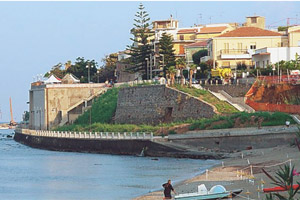Europe stretches from the Arctic Ocean in the north to the Mediterranean Sea, the Black Sea, the Sea of Marmara, the Dardanelles Strait and the Caucasus mountains in the south. It is washed by the Atlantic Ocean in the west and in the east, it is bounded by Asia, from which it is separated by the Ural Mountains, the Ural River and the Caspian Sea.
From north to south, Europe’s geology is formed by a mass of crystalline rocks; an area of mixed structures resulting from by the movement of faults, folds and volcanoes; and a recently formed mountainous area containing the Pyrenees, the Alps, and the Caucasus range, among others. It is also the flattest continent, with an average altitude of 230 metres. Its highest points above sea level are Mount Elbrus (5,462 metres) in Russia, Mount Shkara (5,204m) in Georgia and Mount Blanc (4,807m) in France.
Rivers and seas
Europe’s rivers flow from the centre of the continent outwards. The longest is the Volga in Russia, followed by the Danube in Germany, which flows from west to east before emptying into the Black Sea.
The warm seas that surround the continent make the climate in the majority of Central and Western Europe cold in winter and warm in summer. In the Mediterranean countries (Spain, Italy and Greece) the summer months tend to be hot and dry and the rain mainly falls in autumn and spring. East of Poland the ocean’s moderating effect is reduced, therefore the climate is colder.
Population and Economy
Europe has approximately 935,000,000 inhabitants in a small area of only 10,400,000 km2. The population distribution has gradually stabilised in the last two decades, due to falling birth rates. Nevertheless, the continent has one of the world’s highest life expectancies, exceeding 75 years in most of its countries.
Europe led the world’s economy for a long time, and its main economies are Germany, the United Kingdom, France, Italy and Spain. Several of these countries have built their economies around industrial activity. Ships, vehicles, chemical products, electronic equipment and other high tech products are the main exports.
Agriculture is the main activity in several parts of Europe, with wheat, barley, oats, maize, potatoes and sugar beet being the important crops. Livestock production, especially of cattle, pigs and goats, is the most important activity in western Europe.
The bulk of its forestry products come from the forests in northern Europe. Mining is also important in almost all parts of the continent, especially of charcoal, iron and many other minerals, such as bauxite, copper, manganese, nickel, potassium and mercury.
The Countries
Europe is formed by 47 independent countries: Albania, Andorra, Austria, Belarus, Belgium, Bosnia and Herzegovina, Bulgaria, Croatia, Cyprus, the Czech Republic, Estonia, Finland, France, Germany, Greece, Hungary, Iceland, Ireland, Italy, Latvia, Liechtenstein, Lithuania, Luxembourg, Macedonia, Malta, Moldova, Monaco, Montenegro, the Netherlands, Norway, Poland, Portugal, Romania, Russia, San Marino, Serbia, Slovakia, Slovenia, Spain, Sweden, Switzerland, Turkey, Ukraine, the United Kingdom and the Vatican City.








 Muere Evita
Muere Evita